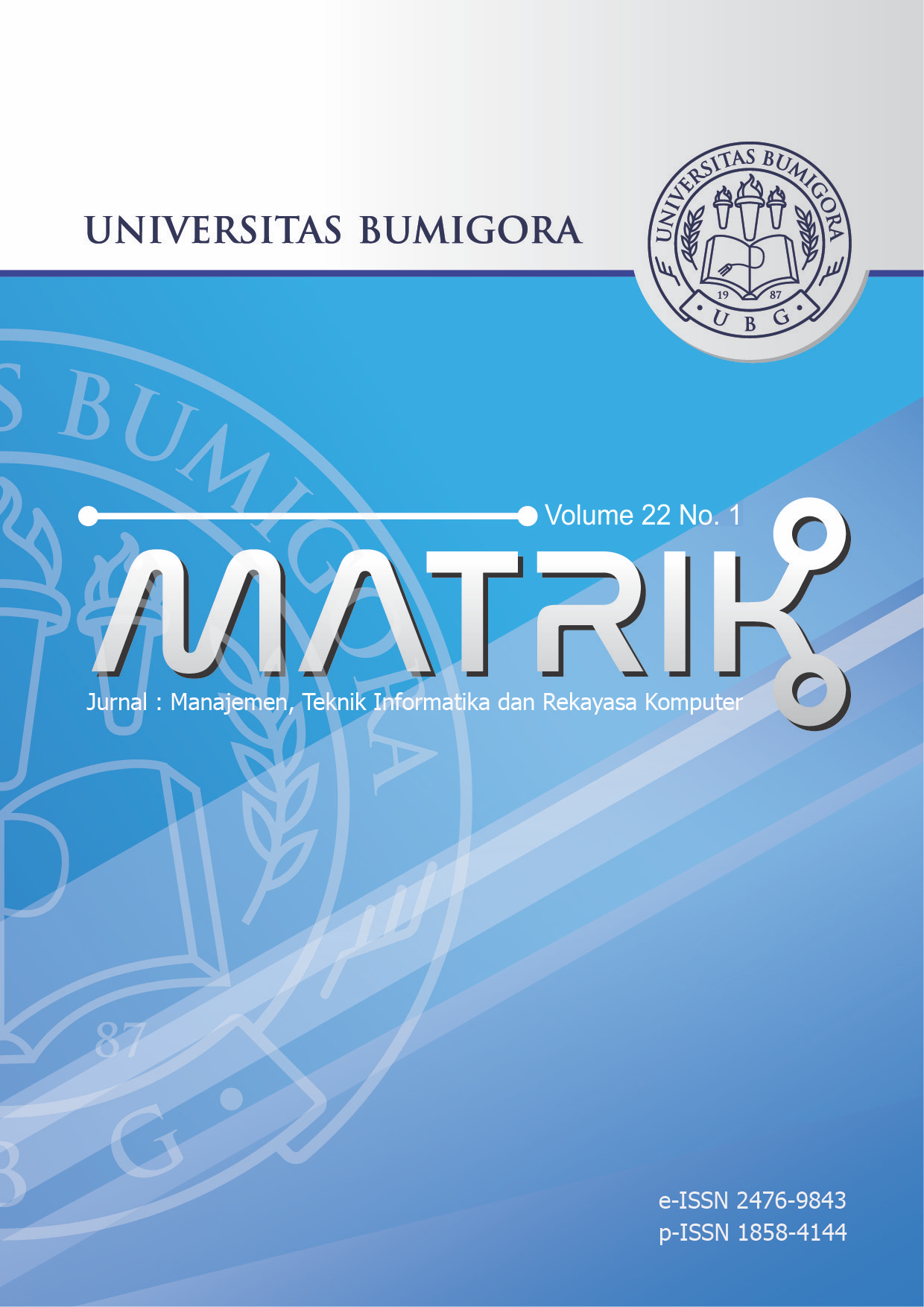The Improvement of Artificial Neural Network Accuracy Using Principle Component Analysis Approach
DOI:
https://doi.org/10.30812/matrik.v22i1.1880Keywords:
Mushroom Classification, Neural Network, Principle Component AnalysisAbstract
An important problem in a classification system is how to get good accuracy results. A way to increase the accuracy of a classifier system is to improve the number of input data attributes. Improving the number of input data attributes can be done using the Principal Component Analysis (PCA) method. The aim of this research is to reduce the number of input data attributes to increase the accuracy in a mushroom classification system. The research method used in this study started from collecting datasets from Kaggle.com related to mushroom-classification, then the data visualization process was carried out using pie charts then a dimension reduction process was carried out to reduce the number of variables using the PCA method. The next step is the training and testing of the artificial neural network. The architecture of artificial neural network used is backward error propagation with the number of hidden layers as much as 2 layers with the number of cells as many as 3 and 2. The training data used is 80%, while the testing data is 20%. Based on the test results, obtained an accuracy of 100% with 150,000 iterations and using 11 input variables from 22 existing input variables. By adding Principal Component Analysis part of the development that can improve the accuracy and performance of Artificial Neural Networks
Downloads
References
[2] I. P. Putra, “Note on Macro Fungi on Belitong Island: Description and Potential,†BIOEDUSCIENCE: Jurnal Pendidikan Biologi dan Sains, vol. 4, no. 1, pp. 11–20, 2020, doi: 10.29405/j.bes/4111-204416.
[3] I. P. Putra, “Studi Taksonomi dan Potensi Beberapa Jamur Liar di Pulau Belitong,†Justek : Jurnal Sains dan Teknologi, vol. 3, no. 1, pp. 24–31, 2020, doi: 10.31764/justek.v3i1.3534.
[4] I. P. Putra, “Kasus keracunan Inocybe sp. di Indonesia,†in Prosiding Seminar Nasional Biologi di Era Pandemi COVID-19, 2020, pp. 148–153.
[5] E. I. Haksoro and A. Setiawan, “Pengenalan Jamur yang Dapat Dikonsumsi Menggunakan Metode Transfer Learning pada Convolutional Neural Network,†Jurnal ELTIKOM : Jurnal Teknik Elektro, Teknologi Informasi dan Komputer, vol. 5, no. 2, pp. 81–91, May 2022, doi: 10.31961/eltikom.v5i2.428.
[6] R. Hayami, S. Soni, and I. Gunawan, “Klasifikasi Jamur Menggunakan Algoritma Naïve Bayes,†Jurnal CoSciTech (Computer Science and Information Technology), vol. 3, no. 1, pp. 28–33, 2022, doi: 10.37859/coscitech.v3i1.3685.
[7] I. P. Putra, “Kasus-Kasus Keracunan Jamur Liar di Indonesia,†Jurnal Ekologi Kesehatan, vol. 20, no. 3, pp. 215–230, Mar. 2022, doi: 10.22435/jek.v20i3.4943.
[8] S. K. Verma and M. Dutta, “Mushroom Classification Using ANN and ANFIS Algorithm,†IOSR Journal of Engineering (IOSRJEN), vol. 08, no. 01, pp. 94–100, 2018.
[9] J. U. Lidasan and M. P. Tagacay, “Mushroom Recognition using Neural Network,†IJCSI International Journal of Computer Science Issues, vol. 15, no. 5, pp. 52–57, 2018.
[10] E. S. Alkronz, K. A. Moghayer, M. Meimeh, M. Gazzaz, B. S. Abu-Nasser, and S. S. Abu-Naser, “Prediction of Whether Mushroom is Edible or Poisonous Using Back-propagation Neural Network,†International Journal of Academic and Applied Research, vol. 3, no. 2, pp. 1–8, 2019, [Online]. Available: http://www.ijeais.org/ijaar.
[11] R. Hanseliani, “Klasifikasi Berbagai Jenis Jamur Layak Konsumsi Dengan Metode Backpropagation,†Universitas Sanata Dharma, 2019.
[12] O. N. Putri, “Implementasi Metode CNN Dalam Klasifikasi Gambar Jamur Pada Analisis Image Processing (Studi Kasus: Gambar Jamur Dengan Genus Agaricus Dan Amanita),†Universitas Islam Indonesia, 2020.
[13] S. Enggari, A. Ramadhanu, and H. Marfalino, “Peningkatan Digital Image Processing Dalam Mendeskripsikan Tumbuhan Jamur Dengan Segmentasi Warna, Deteksi Tepi Dan Kontur,†Jurnal Teknologi Dan Sistem Informasi Bisnis, vol. 4, no. 1, pp. 70–75, 2022, doi: 10.47233/jteksis.v4i1.358.
[14] E. Tanuwijaya and A. Roseanne, “Modifikasi Arsitektur VGG16 untuk Klasifikasi Citra Digital Rempah-Rempah Indonesia,†MATRIK : Jurnal Manajemen, Teknik Informatika dan Rekayasa Komputer, vol. 21, no. 1, pp. 189–196, Nov. 2021, doi: https://doi.org/10.30812/matrik.v21i1.1492.
[15] A. S. Ritonga and I. Muhandhis, “Teknik Data Mining Untuk Mengklasifikasikan Data Ulasan Destinasi Wisata Menggunakan Reduksi Data Principal Component Analysis (PCA),†Jurnal Ilmiah Edutic, vol. 7, no. 2, pp. 124–133, 2021.
[16] A. L. Unihehu and I. Suharjo, “The Klasifikasi Jenis Ikan Berbasis Jaringan Saraf Tiruan Menggunakan Algoritma Principal Component Analysis (PCA),†Jurnal Ilmiah Ilmu Komputer, vol. 7, no. 2, pp. 27–32, 2021, doi: 10.35329/jiik.v7i2.200.
[17] H. Harizahayu, “Pengenalan Ekspresi Raut Wajah Berbasis Jaringan Saraf Tiruan Backpropagation Dengan Metode Principal Component Analysis,†BAREKENG: Jurnal Ilmu Matematika dan Terapan, vol. 15, no. 1, pp. 037–046, Mar. 2021, doi: 10.30598/barekengvol15iss1pp037-046.
[18] D. Frenza and R. Mukhaiyar, “Aplikasi Pengenalan Wajah dengan Metode Adaptive Resonance Theory (ART),†Ranah Research : Journal of Multidisciplinary Research and Development, vol. 3, no. 3, pp. 35–42, 2021, [Online]. Available: https://jurnal.ranahresearch.com/index.php/R2J/article/view/392.
[19] A. Hermawan and D. Avianto, “The Implementation of Neural Network On Determining the Determinant Factors Towards Students’ Stress Resistance,†Journal of Telecommunication, Electronic and Computer Engineering (JTEC), vol. 9, no. 3, pp. 129–133, Sep. 2017, [Online]. Available: https://jtec.utem.edu.my/jtec/article/view/1527.
[20] K. A. Widagdo, K. Adi, and R. Gernowo, “Kombinasi Feature Selection Fisher Score dan Principal Component Analysis (PCA) untuk Klasifikasi Cervix Dysplasia,†Jurnal Teknologi Informasi dan Ilmu Komputer, vol. 7, no. 3, pp. 565–572, 2020, doi: 10.25126/jtiik.2020702987.
Downloads
Published
Issue
Section
How to Cite
Similar Articles
- Denny Indrajaya, Adi Setiawan, Bambang Susanto, Comparison of k-Nearest Neighbor and Naive Bayes Methods for SNP Data Classification , MATRIK : Jurnal Manajemen, Teknik Informatika dan Rekayasa Komputer: Vol. 22 No. 1 (2022)
- M Safii, Husain Husain, Khairan Marzuki, Support Vector Machine Optimization for Diabetes Prediction Using Grid Search Integrated with SHapley Additive exPlanations , MATRIK : Jurnal Manajemen, Teknik Informatika dan Rekayasa Komputer: Vol. 25 No. 1 (2025)
- Indradi Rahmatullah, Gibran Satya Nugraha, Arik Aranta, Feature Selection on Grouping Students Into Lab Specializations for the Final Project Using Fuzzy C-Means , MATRIK : Jurnal Manajemen, Teknik Informatika dan Rekayasa Komputer: Vol. 23 No. 1 (2023)
- Rizky Afrinanda, Lusiana Efrizoni, Wirta Agustin, Rahmiati Rahmiati, Hybrid Model for Sentiment Analysis of Bitcoin Prices using Deep Learning Algorithm , MATRIK : Jurnal Manajemen, Teknik Informatika dan Rekayasa Komputer: Vol. 22 No. 2 (2023)
- Khairunnisak Nur Isnaini, Didit Suhartono, Evaluation of Basic Principles of Information Security at University Using COBIT 5 , MATRIK : Jurnal Manajemen, Teknik Informatika dan Rekayasa Komputer: Vol. 21 No. 2 (2022)
- Abulwafa Muhammad, Sarjon Defit, Analyzing the use of Social Media by Fashion Designers with K-Means and C45 , MATRIK : Jurnal Manajemen, Teknik Informatika dan Rekayasa Komputer: Vol. 21 No. 2 (2022)
- Evan Tanuwijaya, Angelica Roseanne, Modifikasi Arsitektur VGG16 untuk Klasifikasi Citra Digital Rempah-Rempah Indonesia , MATRIK : Jurnal Manajemen, Teknik Informatika dan Rekayasa Komputer: Vol. 21 No. 1 (2021)
- Ni Putu Nanik Hendayanti, Maulida Nurhidayati, Siti Soraya, Habib Ratu Perwira Negara, Community Purchase Decision Modeling in Bali with Non-Linier Methods , MATRIK : Jurnal Manajemen, Teknik Informatika dan Rekayasa Komputer: Vol. 21 No. 3 (2022)
- Samsurizal Samsurizal, Arif Nur Afandi, Mohamad Rodhi Faiz, Artificial Intelligence Enhanced Direct Current Fast ChargingIntegration for Electric Vehicles on 20 kV Grids: A Technical andOntological Study , MATRIK : Jurnal Manajemen, Teknik Informatika dan Rekayasa Komputer: Vol. 24 No. 3 (2025)
- Jusmita Weriza, Ismail Husein, Noranizamardia Noranizamardia, M Fakhariza, Khairan Marzuki, Development of OnlineWeb-Based New Student Graduation Application in Junior High School , MATRIK : Jurnal Manajemen, Teknik Informatika dan Rekayasa Komputer: Vol. 21 No. 3 (2022)
You may also start an advanced similarity search for this article.
Most read articles by the same author(s)
- Aditya Dwi Putro, Arief Hermawan, Pengaruh Cahaya dan Kualitas Citra dalam Klasifikasi Kematangan Pisang Cavendish Berdasarkan Ciri Warna Menggunakan Artificial Neural Network , MATRIK : Jurnal Manajemen, Teknik Informatika dan Rekayasa Komputer: Vol. 21 No. 1 (2021)
- Muhammad Rizki, Arief Hermawan, Donny Avianto, Learning Accuracy with Particle Swarm Optimization for Music Genre Classification Using Recurrent Neural Networks , MATRIK : Jurnal Manajemen, Teknik Informatika dan Rekayasa Komputer: Vol. 23 No. 2 (2024)


.png)












